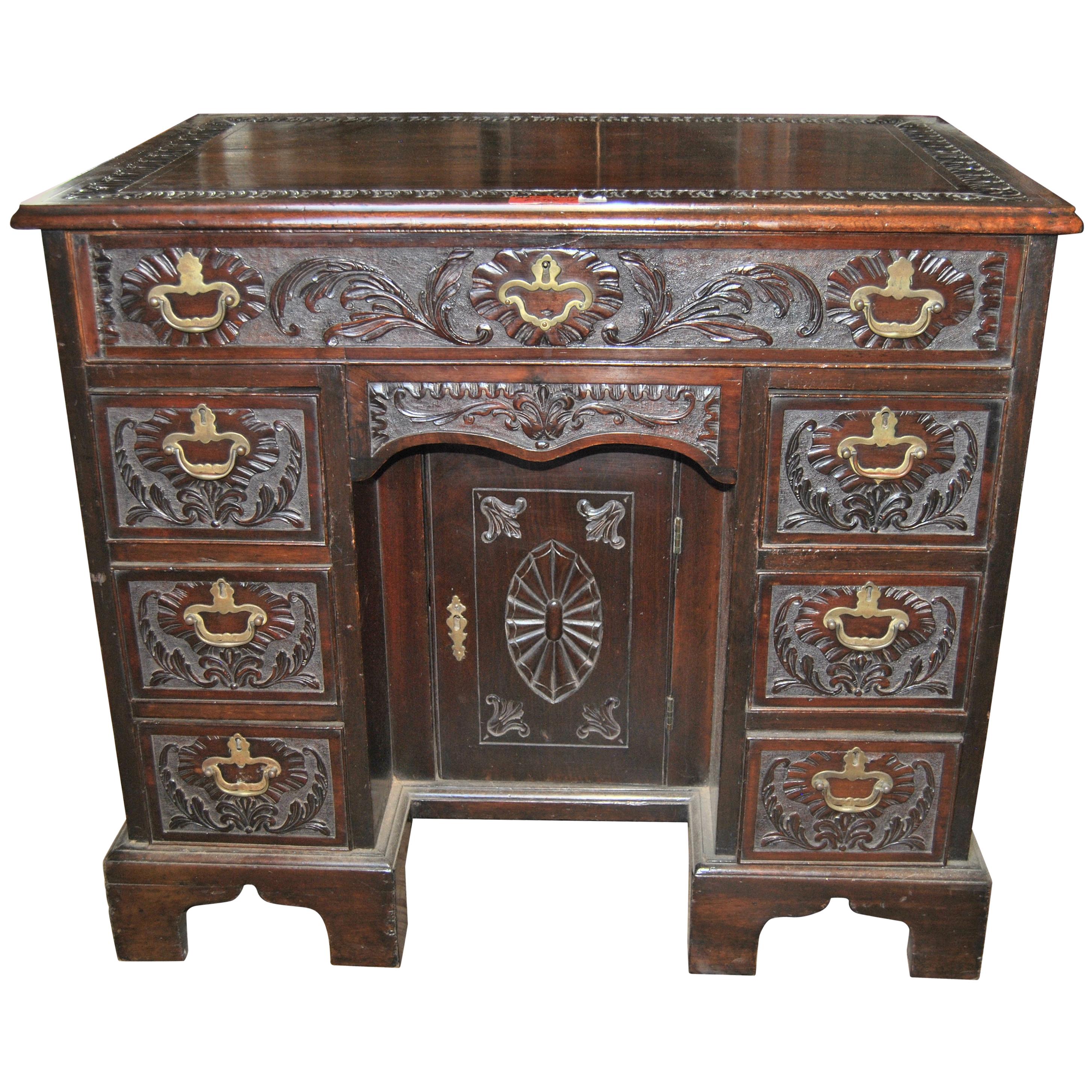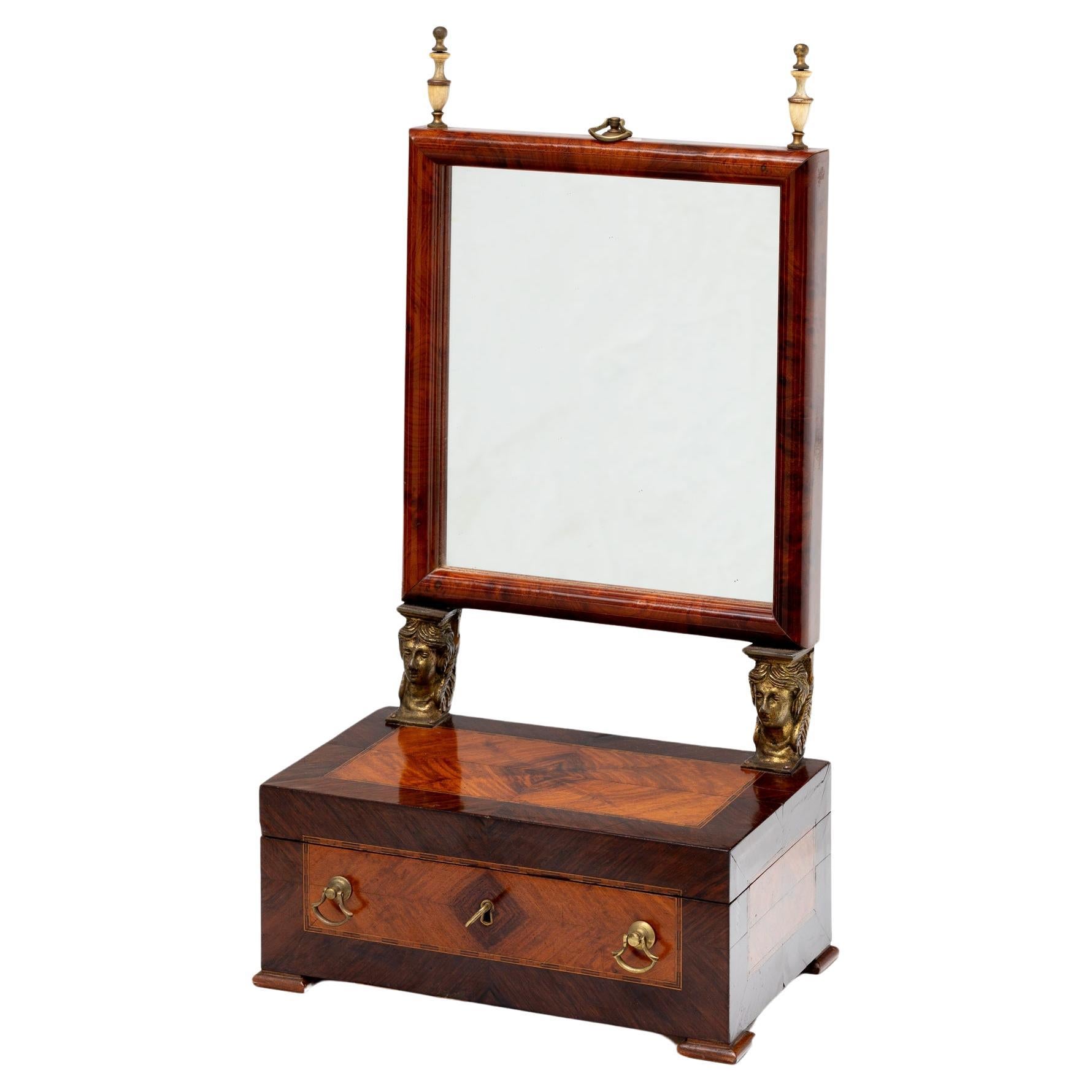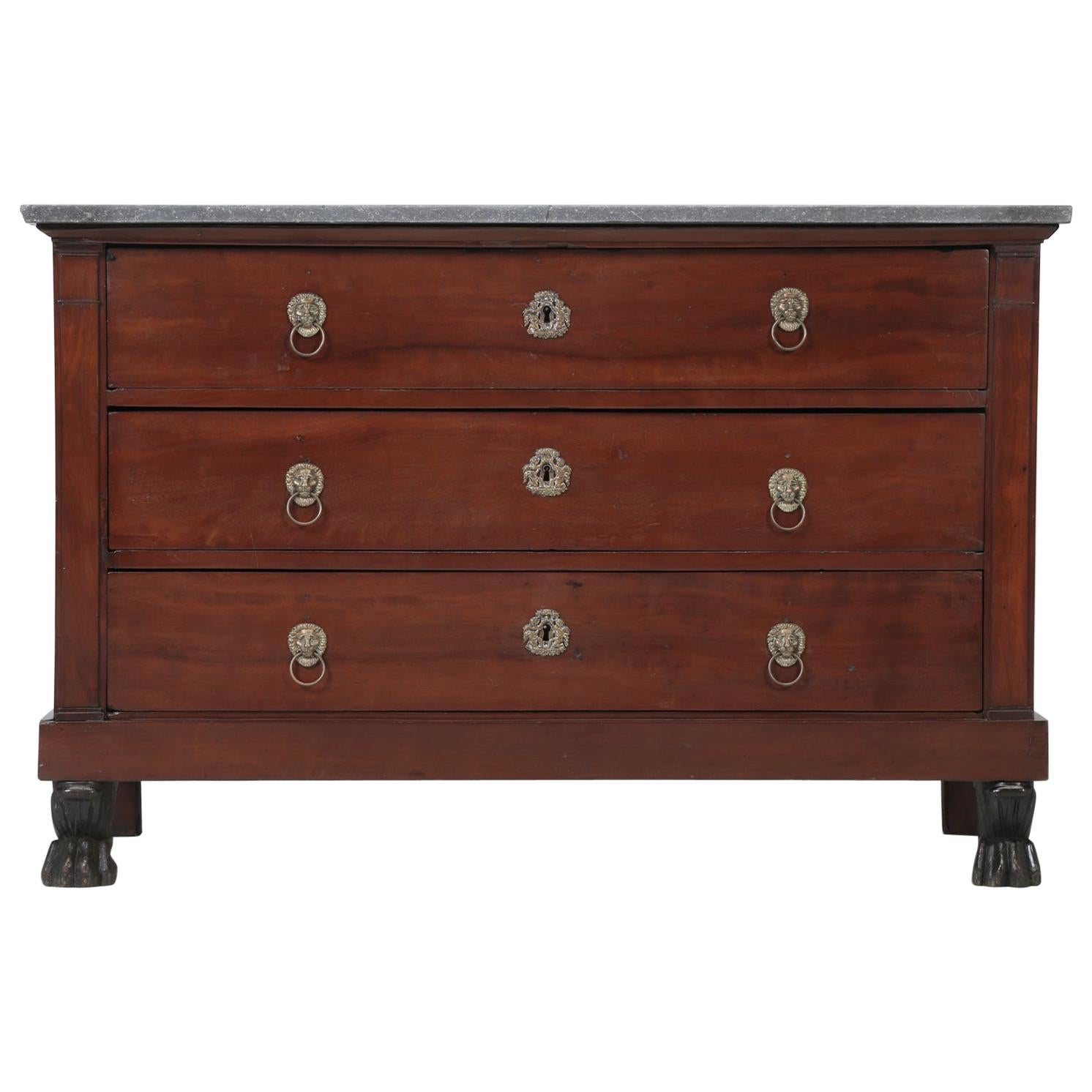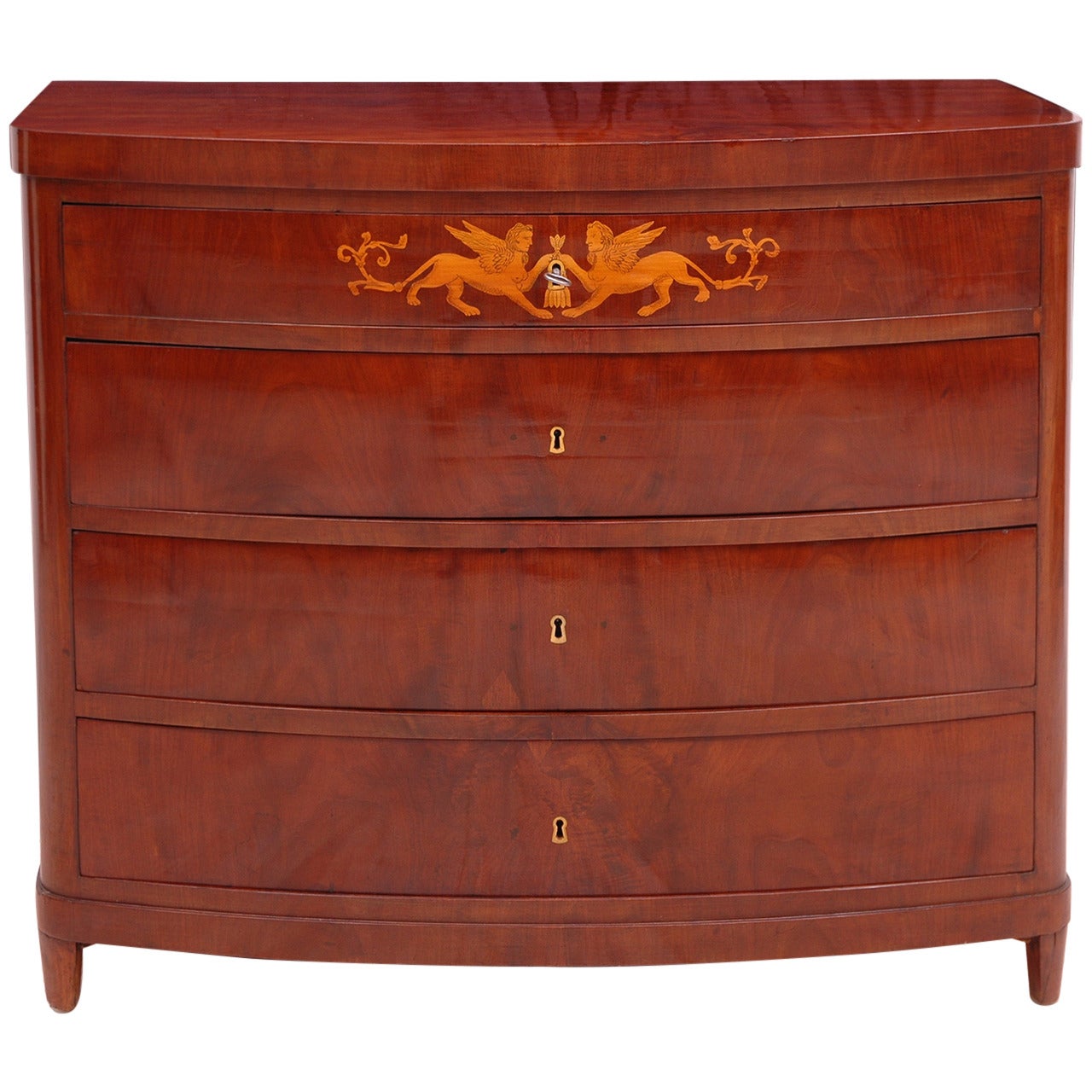Items Similar to Russian Empire Dressing Table with Mahogany Carvings and Gilt Bronzes
Want more images or videos?
Request additional images or videos from the seller
1 of 12
Russian Empire Dressing Table with Mahogany Carvings and Gilt Bronzes
About the Item
The desk body is made of pine and oak with a Karelian birch veneer and the mirrored base is supported by four curved feet, embellished by an entwined patinated bronze snake with a gilt head and tail. The pad feet are supported by ebonized mahogany floor plates.
The middle portion consists of five small drawers and a large desk drawer and within a manufactured mahogany interior with seven compartments and eight secret compartments as well as two movable elements, one of which is covered with velvet. The lower drawers have gilt gooseneck fittings.
The mirror attachment includes a mechanism for taking the mirror plate vertically out and up to 180 degrees, which can, in turn, be fixed in almost any position. This mirror is flanked by two carved mahogany phoenixes with gilt heads and feet, and on the reverse side there are two more secret compartments in the lower area of the right as well as the left foot of the base.
The Poudreuse Secretary is an exceptional example of Russian furniture of the first quarter of the nineteenth century. The depiction and symbolic arrangement of the remarkable bronze snakes and the carved phoenix is typical of the style of the important Russian architect Andrey Voronikhin (1759-1814). As well, this Poudreuse Secretary Desk has as well a similar structure to a dressing table made by the celebrated cabinetmaker (ebéniste) Heinrich Gambs (1765–1831) and is similar to pieces produced by these two leading figures. As Antoine Chenevière notes: “It should not be forgotten that the great majority - if not all - of these pieces (Gamb’s) are unsigned. However, it is sometimes possible to identify the work of a particular craftsman.”
Poudreuse is a French name for a table originally created in the seventeenth century for cosmetics. As a retreat and dressing room for women, boudoirs were often very elaborate and fitted with high-quality furnishings and a remarkable Poudreuse desk like this one would be a custom and central furnishing of such an elegantly appointed room. The outstanding quality of this Poudreuse Desk indicates the original owner was of very high social standing. As well, while Russian furniture art was strongly influenced by France and Germany and there were many imports to Russia throughout the eighteenth century, it should also be noted that the local cabinetmakers quickly learned to produce furniture including H. Gambs and A. Voronikhin’s exceptional products either on behalf of the Tsar family or other families of aristocratic descent.
As we can see from a number of extant drawings, when designing and executing their projects, during this period, Russian architects paid special attention to the furnishings and the integration into their overall design concept of the rooms. Specifically, Voronikhin’s work is described as follows: “He built numerous buildings in and around St. Petersburg, and he always took great care in the interior decoration, producing large numbers of drawings for objets d’art and furniture.”1 Chenevière also describes the collaboration between Heinrich Gambs, one of the most important Russian cabinetmakers and the key architect and designer Voronikhin: “From about 1805 he made furniture for the designs of Voronikhin.”
Furthermore, in reference to the motifs seen in this Poudreuse Desk, Voronikhin’s designs often included swans and snakes particularly in the allegorical depiction of snakes and birds together.. A particularly striking comparison is made with the similar designs of snakes on a chair designed by Voronikhin compared to the snakes of this Poudreuse Desk. As well, there is also similarity seen in this desk’s carved mahogany phoenix feathers and the feathered armrests of a chair designed by Voronikhin. Overall, the high quality of the sculptural embellishment adds to the exceptional quality of this piece.
Chenevière makes note of the complex process of constructing such a piece of ornate furnishing: “The workshop of H. Gambs has several different sections responsible for the different stages of furniture-making. One craftsman would be in charge of constructing the carcase and applying the veneer, another would cut out the brass motifs and friezes and fix them on the prepared base of dark wood, a third would be responsible for the casting, and applying or patination of the bronze ornaments, a fourth would devise and install secret compartments and mechanical devices, and so on.“
As well it has been observed by N.V Ugleva that “the workshop of Heinrich Gambs was famous for furniture with secret hiding places.”2 And indeed, there are various mechanical secret hiding places in this Poudreuse Desk interior, in the base of the mirror and at the back of the base. The fold-out dressing mirror, which rotates vertically, as well as on its own axis and can be fixed at a desired position, is another indication of the involvement of the workshop of Gambs.
Such specialized craftsmanship likely also led to the rare symbolic detail of the pearl necklace of gooseneck-shaped fitting. Ugleva explains: “The pearl necklace on the bird’s neck, however, is an extremely rare item [...]. First, there is a well-known tradition of the House of Romanov [...] there was a string of pearls as a symbol of innocence and girlish purity.” This motif, of course, points to questions about the original owner of the desk.
Finally, it should be observed that until around 1810, mahogany wood was mostly used for the production of high-quality furniture including construction, carvings, interior work, and veneer work. The stylistic and structural construction during this time was rather strict and straightforward. Both stylistic features changed greatly in the following years.
Chenevière notes: «Gradually, however, a new tendency can be discerned: to give precedence to natural wood,” Mahogany or indigenous, like “Karelian birch” and “bronze ornaments” more and more. This was to be the dominant trait of the years 1810-1825».
Likewise, this Poudreuse Desk is made of mainly native woods used in Russia (the blind is made of pine and oak). The desk has a veneer characteristic of Russia Karelian birch: “Nowadays it has become a symbol of the nations’ furniture production”.
Overall, the design emphasizes individual architectural elements (such as the pedestal, base, the central section, and mirror). As well, the contrast of the warm tone of the Karelian Birch with the ebonized wood strip and mahagony moldings provide a sense of ornate depth and richness. According to Chenevière this approach was often used during this period: “In addition, they use ebony or ebonized woods as a means of heightening the warmth of natural wood, contrasting the black and honey colors.”
Furthermore, the carved phoenix, drawers, and the intricately crafted interior are made of mahogany wood and the desk is decorated with four elaborate patinated bronze serpents with gilt heads and tales. As Chenevière observes such combinations had a «Curiosity value - tapestry panels, for example, which came into fashion in about 1805, or indigenous woods such as stained birch»1 This combination of Russian wood and ornate gilded and bronze ornaments date this Poudreuse desk to the end of the first part (1800 and 1810) and the beginning of the second part (1810-1825) of the Russian Empire.
Made during the height of Russian furniture production, this exceptional Poudreuse Secretary showcases the style and characteristics of furniture produced in the first and second half of the Russian Empire, including a high level of craftsmanship, period decoration, and material. Such furnishings were made for members of the Imperial Court and aristocracy by Gambs and Voronikhin and other workshops in this style.
Footnotes: 1. Chenevière Antoine. Russian Furniture: The Golden Age, 1780-1840. Weidenfeld & Nicholson, (1988), pp. 38, 51, 103, 143, 155, 165, 177, 182, 195. 2. Ugleva Natalja Vladimirowna. Furniture of Heinrich Gambs – In The Hermitage Collection. The State Hermitage Museum. St. Petersburg: The State Hermitage Publishers, (2016), pp. 41-43.
- Similar to:Andrey Voronikhin (Designer)
- Dimensions:Height: 61.42 in (156 cm)Width: 37.01 in (94 cm)Depth: 18.9 in (48 cm)
- Style:Empire (Of the Period)
- Materials and Techniques:
- Place of Origin:
- Period:
- Date of Manufacture:1810
- Condition:Refinished. Wear consistent with age and use. beautiful restored condition with shellack finish.
- Seller Location:Vienna, AT
- Reference Number:1stDibs: LU1050627080472
About the Seller
4.8
Platinum Seller
These expertly vetted sellers are 1stDibs' most experienced sellers and are rated highest by our customers.
Established in 2007
1stDibs seller since 2014
193 sales on 1stDibs
Typical response time: 1 hour
- ShippingRetrieving quote...Ships From: Vienna, Austria
- Return PolicyA return for this item may be initiated within 7 days of delivery.
More From This SellerView All
- 18th Century French Country Provincial Grey White and Gold Painted CommodeLocated in Vienna, ATThis extraordinary antique provincial commode or chest of drawers is made from Oak wood in France at the end of the 18th Century. The chest has two drawers, each with a separate work...Category
Antique Late 18th Century French French Provincial Commodes and Chests o...
MaterialsBrass
- Scandinavian Modern Teak and Brass Table Lamp with Original Paper ShadeBy ESALocated in Vienna, ATA charming small Scandinavian Modern brass table or desk lamp in a sculptural shape. it´s base is hand-turned from a single teak block of richly grained and warmly toned texture and ...Category
Vintage 1960s Danish Scandinavian Modern Table Lamps
MaterialsBrass
- Austrian Midcentury Beechwood Side Table with Cord and Glass Top by Max KmentBy Kunstgewerbliche Werkstätte Max Kment, Max KmentLocated in Vienna, ATAmazing Austrian midcentury side table or coffee table designed by the Austrian Architect Max Kment and manufactured by his Kunstgewerbliche Werkstätte in Vienna in the early 1950s. ...Category
Vintage 1950s Austrian Mid-Century Modern Side Tables
MaterialsCord, Glass, Beech
- Austrian Midcentury Beechwood Side Table with Cord and Glass Top by Max KmentBy Kunstgewerbliche Werkstätte Max Kment, Max KmentLocated in Vienna, ATAmazing Austrian midcentury side table or coffee table designed by the Austrian Architect Max Kment and manufactured by his Kunstgewerbliche Werkstätte in Vienna in the early 1950s. ...Category
Vintage 1950s Austrian Mid-Century Modern Side Tables
MaterialsCord, Glass, Beech
- Italian Midcentury Mahogany and Brass Magazine Rack in the Style of Ico ParisiBy Ico ParisiLocated in Vienna, ATElegant Italian midcentury brass and mahogany magazine rack in the style of Ico Parisi. Wonderful addition to any Mid-Century Modern interior!Category
Vintage 1950s Italian Mid-Century Modern Magazine Racks and Stands
MaterialsBrass
- Circular Italian Midcentury Brass and Glass Coffee TableBy Fontana ArteLocated in Vienna, ATThis fantastic midcentury circular brass and glass coffee or side table has been designed and produced in Italy in the 1950s. It features a elegant star shaped tripod brass base and ...Category
Vintage 1950s Italian Mid-Century Modern Coffee and Cocktail Tables
MaterialsBrass
You May Also Like
- 18th Century Carved Mahogany Dressing TableLocated in Savannah, GAThis is a dressing table made in England, circa 1770. It is made of solid mahogany and is beautifully hand carved throughout with fine quality deep carving. The top has a molded edge...Category
Antique 1770s English George III Commodes and Chests of Drawers
MaterialsMahogany
- American Empire Gothic Mahogany Dressing TableLocated in New York, NYAmerican Empire Gothic design mahogany dressing table on carved pedestal base with mirror and drawers.Category
20th Century American Empire Dressers
MaterialsMahogany
- XX Century Empire Style Dressing Table with Ivory and BronzeLocated in Lisboa, PTEmpire Style Dressing Table, features a mirror and a small compartiment, that can be closed with a key. European made, from the 20th Century. Empire-style furniture draws its inspiration from the Napoleonic era, particularly the designs that flourished during Napoleon Bonaparte's reign in France. This style is characterized by grandeur, symmetry, and classical motifs. The use of bronze and ivory...Category
Mid-20th Century European Empire Dressers
MaterialsBronze
- Antique French Empire Mahogany Commode with Lion Paw Feet, French PolishedLocated in Chicago, ILAntique French Commode with wonderful lion paw feet, in the Empire style, although we have seen this style referred to as restoration as well. Old plank has a history of purchasing anything with animal related feet and especially the lion paw style. Just take a peek at our lion paw sofa...Category
Antique 1890s French Empire Commodes and Chests of Drawers
MaterialsMahogany
- CRIS dressing table with Antique Brass Feet and HandlesLocated in Frazão, PortoCRIS dressing table is a very elegant piece that suits perfectly in both classic and modern bedrooms. Made of lacquered wood with details in metal...Category
21st Century and Contemporary Portuguese Modern Dressers
MaterialsBrass, Stainless Steel
- Antique Empire Chest of Drawers in Cuban Mahogany with Interior Writing SurfaceLocated in Miami, FLA very fine Empire chest or commode with bowed front offering four drawers on tapered feet in the finest book-matched Cuban (West Indies) mahogany. Satinwood inlays depicting two sph...Category
Antique 1810s Danish Empire Commodes and Chests of Drawers
MaterialsMahogany, Satinwood
Recently Viewed
View AllMore Ways To Browse
Gilt Heads
Antique Russian Furniture
Dressing Table With
Small Table With Storage
Craft Table With Storage
Bronze Mahogany Gilt
Large Sculptural Pieces
Mahogany With Gilt Bronze Furniture
Work Table With Storage
Russian Bronze
Bronze Russia
Two Antique Dressers
Mahogany Empire Storage And Case Pieces
French Mahogany Gilt Cabinets
Bronze Gilt Plate
Empire Mahogany Bronze
Antique Dresser Drawer
Russian Head





